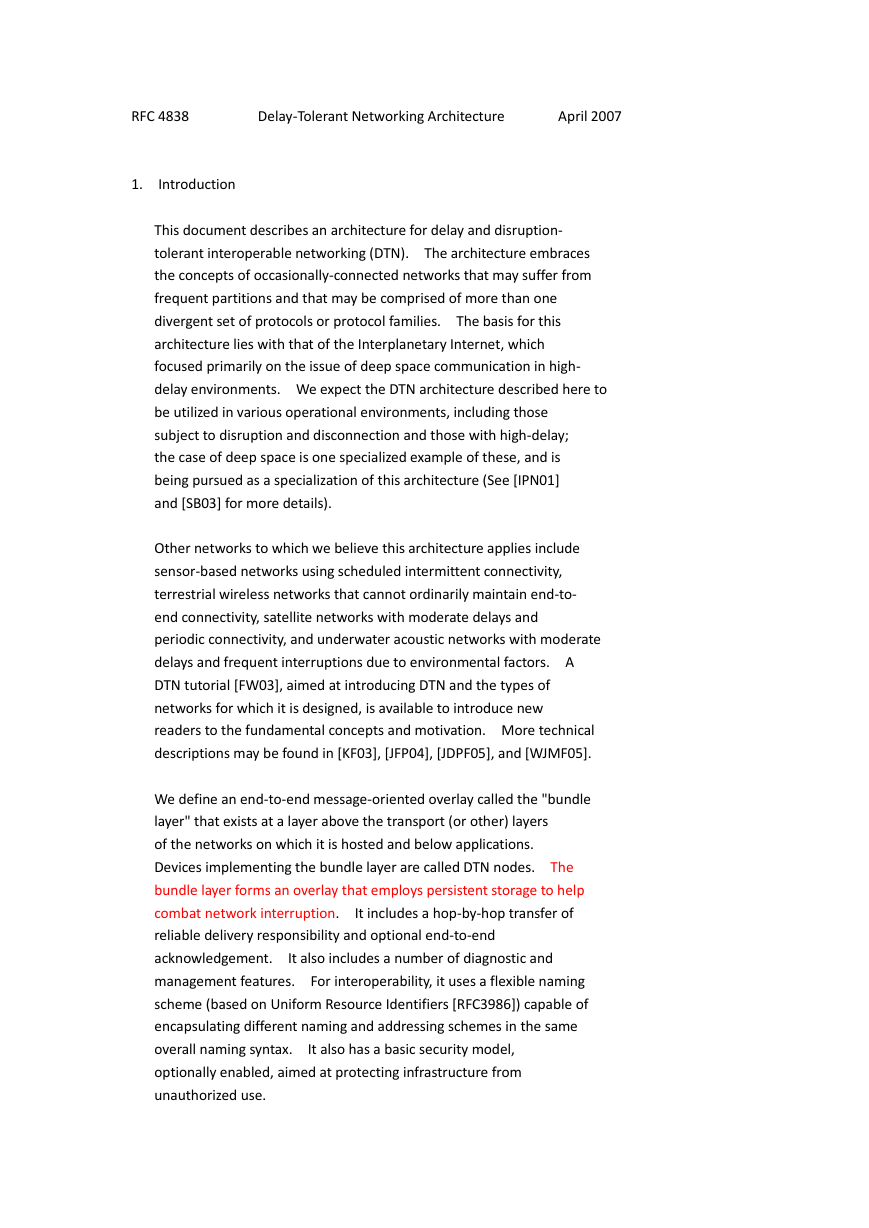Network Working Group V. Cerf
Request for Comments: 4838 Google/Jet Propulsion Laboratory
Category: Informational S. Burleigh
A. Hooke
L. Torgerson
NASA/Jet Propulsion Laboratory
R. Durst
K. Scott
The MITRE Corporation
K. Fall
Intel Corporation
H. Weiss
SPARTA, Inc.
April 2007
Delay-Tolerant Networking Architecture
Status of This Memo(备忘录)
This memo provides information for the Internet community. It does
not specify an Internet standard of any kind. Distribution of this
memo is unlimited.
Copyright Notice
Copyright (C) The IETF Trust (2007).
IESG Note
This
is a product of the Internet Research Task Force and is not
a candidate for any level of Internet Standard. The IRTF publishes 候选者
the results of Internet-related research and development activities.
These results might not be suitable for deployment on the public 配置文件
Internet.
Abstract
This document describes an architecture for delay-tolerant and
disruption-tolerant networks, and is an evolution of the architecture
originally designed for the Interplanetary Internet, a communication 行星间的
system envisioned to provide Internet-like services across
interplanetary distances in support of deep space exploration.
�
This document describes an architecture that addresses a variety of
problems with internetworks having operational and performance
characteristics that make conventional (Internet-like) networking
approaches either unworkable or impractical. We define a message-
oriented overlay that exists above the transport (or other) layers of
Cerf, et al. Informational [Page 1]
�
RFC 4838 Delay-Tolerant Networking Architecture April 2007
the networks it interconnects. The document presents a motivation
for the architecture, an architectural overview, review of state
management required for its operation, and a discussion of
application design issues. This document represents the consensus of
the IRTF DTN research group and has been widely reviewed by that
group.
Table of Contents
1. Introduction ....................................................3
2. Why an Architecture for Delay-Tolerant Networking? ..............4
3. DTN Architectural Description ...................................5
3.1. Virtual Message Switching Using Store-and-Forward
Operation ..................................................5
3.2. Nodes and Endpoints ........................................7
3.3. Endpoint Identifiers (EIDs) and Registrations ..............8
3.4. Anycast and Multicast .....................................10
3.5. Priority Classes ..........................................10
3.6. Postal-Style Delivery Options and Administrative Records ..11
3.7. Primary Bundle Fields .....................................15
3.8. Routing and Forwarding ....................................16
3.9. Fragmentation and Reassembly ..............................18
3.10. Reliability and Custody Transfer .........................19
3.11. DTN Support for Proxies and Application Layer Gateways ...21
3.12. Timestamps and Time Synchronization ......................22
3.13. Congestion and Flow Control at the Bundle Layer ..........22
3.14. Security .................................................23
4. State Management Considerations ................................25
4.1. Application Registration State ............................25
4.2. Custody Transfer State ....................................26
4.3. Bundle Routing and Forwarding State .......................26
4.4. Security-Related State ....................................27
4.5. Policy and Configuration State ............................27
5. Application Structuring Issues .................................28
6. Convergence Layer Considerations for Use of Underlying
Protocols ......................................................28
7. Summary ........................................................29
8. Security Considerations ........................................29
9. IANA Considerations ............................................30
10. Normative References ..........................................30
11. Informative References ........................................30
�
12. Acknowledgments ...............................................32
Cerf, et al. Informational [Page 2]
�
RFC 4838 Delay-Tolerant Networking Architecture April 2007
1. Introduction
This document describes an architecture for delay and disruption-
tolerant interoperable networking (DTN). The architecture embraces
the concepts of occasionally-connected networks that may suffer from
frequent partitions and that may be comprised of more than one
divergent set of protocols or protocol families. The basis for this
architecture lies with that of the Interplanetary Internet, which
focused primarily on the issue of deep space communication in high-
delay environments. We expect the DTN architecture described here to
be utilized in various operational environments, including those
subject to disruption and disconnection and those with high-delay;
the case of deep space is one specialized example of these, and is
being pursued as a specialization of this architecture (See [IPN01]
and [SB03] for more details).
Other networks to which we believe this architecture applies include
sensor-based networks using scheduled intermittent connectivity,
terrestrial wireless networks that cannot ordinarily maintain end-to-
end connectivity, satellite networks with moderate delays and
periodic connectivity, and underwater acoustic networks with moderate
delays and frequent interruptions due to environmental factors. A
DTN tutorial [FW03], aimed at introducing DTN and the types of
networks for which it is designed, is available to introduce new
readers to the fundamental concepts and motivation. More technical
descriptions may be found in [KF03], [JFP04], [JDPF05], and [WJMF05].
We define an end-to-end message-oriented overlay called the "bundle
layer" that exists at a layer above the transport (or other) layers
of the networks on which it is hosted and below applications.
Devices implementing the bundle layer are called DTN nodes. The
bundle layer forms an overlay that employs persistent storage to help
combat network interruption. It includes a hop-by-hop transfer of
reliable delivery responsibility and optional end-to-end
acknowledgement. It also includes a number of diagnostic and
management features. For interoperability, it uses a flexible naming
scheme (based on Uniform Resource Identifiers [RFC3986]) capable of
encapsulating different naming and addressing schemes in the same
overall naming syntax. It also has a basic security model,
optionally enabled, aimed at protecting infrastructure from
unauthorized use.
�
The bundle layer provides functionality similar to the internet layer
of gateways described in the original ARPANET/Internet designs
[CK74]. It differs from ARPANET gateways, however, because it is
layer-agnostic and is focused on virtual message forwarding rather
than packet switching. However, both generally provide
interoperability between underlying protocols specific to one
Cerf, et al. Informational [Page 3]
�
RFC 4838 Delay-Tolerant Networking Architecture April 2007
environment and those protocols specific to another, and both provide
a store-and-forward forwarding service (with the bundle layer
employing persistent storage for its store and forward function).
In a sense, the DTN architecture provides a common method for
interconnecting heterogeneous gateways or proxies that employ store-
and-forward message routing to overcome communication disruptions.
It provides services similar to electronic mail, but with enhanced
naming, routing, and security capabilities. Nodes unable to support
the full capabilities required by this architecture may be supported
by application-layer proxies acting as DTN applications.
2. Why an Architecture for Delay-Tolerant Networking?
Our motivation for pursuing an architecture for delay tolerant
networking stems from several factors. These factors are summarized
below; much more detail on their rationale can be explored in [SB03],
[KF03], and [DFS02].
The existing Internet protocols do not work well for some
environments, due to some fundamental assumptions built into the
Internet architecture:
- that an end-to-end path between source and destination exists for
the duration of a communication session
- (for reliable communication) that retransmissions based on timely
and stable feedback from data receivers is an effective means for
repairing errors
- that end-to-end loss is relatively small
- that all routers and end stations support the TCP/IP protocols
- that applications need not worry about communication performance
- that endpoint-based security mechanisms are sufficient for meeting
most security concerns
- that packet switching is the most appropriate abstraction for
interoperability and performance
�
- that selecting a single route between sender and receiver is
sufficient for achieving acceptable communication performance
The DTN architecture is conceived to relax most of these assumptions,
based on a number of design principles that are summarized here (and
further discussed in [KF03]):
Cerf, et al. Informational [Page 4]
�
















 2023年江西萍乡中考道德与法治真题及答案.doc
2023年江西萍乡中考道德与法治真题及答案.doc 2012年重庆南川中考生物真题及答案.doc
2012年重庆南川中考生物真题及答案.doc 2013年江西师范大学地理学综合及文艺理论基础考研真题.doc
2013年江西师范大学地理学综合及文艺理论基础考研真题.doc 2020年四川甘孜小升初语文真题及答案I卷.doc
2020年四川甘孜小升初语文真题及答案I卷.doc 2020年注册岩土工程师专业基础考试真题及答案.doc
2020年注册岩土工程师专业基础考试真题及答案.doc 2023-2024学年福建省厦门市九年级上学期数学月考试题及答案.doc
2023-2024学年福建省厦门市九年级上学期数学月考试题及答案.doc 2021-2022学年辽宁省沈阳市大东区九年级上学期语文期末试题及答案.doc
2021-2022学年辽宁省沈阳市大东区九年级上学期语文期末试题及答案.doc 2022-2023学年北京东城区初三第一学期物理期末试卷及答案.doc
2022-2023学年北京东城区初三第一学期物理期末试卷及答案.doc 2018上半年江西教师资格初中地理学科知识与教学能力真题及答案.doc
2018上半年江西教师资格初中地理学科知识与教学能力真题及答案.doc 2012年河北国家公务员申论考试真题及答案-省级.doc
2012年河北国家公务员申论考试真题及答案-省级.doc 2020-2021学年江苏省扬州市江都区邵樊片九年级上学期数学第一次质量检测试题及答案.doc
2020-2021学年江苏省扬州市江都区邵樊片九年级上学期数学第一次质量检测试题及答案.doc 2022下半年黑龙江教师资格证中学综合素质真题及答案.doc
2022下半年黑龙江教师资格证中学综合素质真题及答案.doc